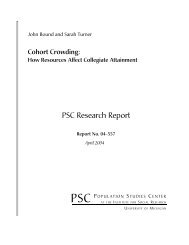Tracking metropolitan America into the 21st century - Population ...
Tracking metropolitan America into the 21st century - Population ...
Tracking metropolitan America into the 21st century - Population ...
You also want an ePaper? Increase the reach of your titles
YUMPU automatically turns print PDFs into web optimized ePapers that Google loves.
over time as users gradually adapt tothis new system.Moving to <strong>the</strong> new classificationscheme is, at its root, a statistical policychange—not a programmatic one.In fact, in its guidance announcing <strong>the</strong>revised definitions, OMB cautionsgovernment agencies against employing<strong>the</strong> definitions to develop andimplement “nonstatistical programsand policies without full considerationof <strong>the</strong> effects of using <strong>the</strong>se definitionsfor such purposes.” Yet as <strong>the</strong> new systemgains acceptance and wider use,policymakers, researchers, and even<strong>the</strong> man on <strong>the</strong> street may confront anew way of looking at <strong>the</strong> world—or atleast <strong>the</strong>ir particular corners of it.Below we discuss <strong>the</strong> effects that<strong>the</strong>se new <strong>metropolitan</strong> standards willhave on federal policy, research, and<strong>the</strong> public at large.Federal PolicyThe federal government’s use of <strong>the</strong><strong>metropolitan</strong> area concept for purposeso<strong>the</strong>r than mere statisticalreporting is widespread. This shouldnot be surprising, since <strong>the</strong> distincteconomic character metro areas aredesigned to exhibit makes <strong>the</strong>m goodapproximations for labor markets,commuter sheds, and air-qualityregions. The U.S. Code alone—<strong>the</strong>federal government’s body of law—contains over 60 unique mentions of<strong>the</strong> phrase “<strong>metropolitan</strong> statisticalarea.”Policymakers really put <strong>the</strong> conceptto work, though, in <strong>the</strong> implementationof federal laws through regulation.Nearly every major federalagency—from those involved in agricultureto homeland security to education—overseesone or more programsthat make use of OMB-defined <strong>metropolitan</strong>areas. Federal agencies typicallyuse <strong>the</strong> <strong>metropolitan</strong> areaconcept as a basis for reporting information,to establish program eligibility,and/or to set program features; anexample of each is offered here. 271. As a basis for reporting information—HomeMortgageDisclosureUnder <strong>the</strong> regulations that implement<strong>the</strong> Home Mortgage DisclosureAct (HMDA), federally-insureddepository institutions must collectinformation on applications forhome mortgage loans. In addition tocharacteristics of <strong>the</strong> applicant, <strong>the</strong>institution must collect informationabout <strong>the</strong> property to which <strong>the</strong>application relates, including itslocation by <strong>metropolitan</strong> area, state,county, and census tract. Institutionsmust compile and report thisinformation to <strong>the</strong> appropriatebanking regulators (e.g., <strong>the</strong> FederalReserve, <strong>the</strong> Comptroller of <strong>the</strong>Currency, etc.) annually. Metropolitanareas typically represent <strong>the</strong>marketplaces within which banksand thrifts operate, and thus serveas important geographic frames forevaluating lending performanceunder o<strong>the</strong>r laws related to HMDA,such as fair lending laws and <strong>the</strong>Community Reinvestment Act. As<strong>metropolitan</strong> areas change and growin size, banks and thrifts must<strong>the</strong>refore change <strong>the</strong>ir informationand reporting procedures to bring<strong>the</strong>ir data—and lending practices—<strong>into</strong> line with <strong>the</strong> new <strong>metropolitan</strong>definitions.2. To establish program eligibilityor applicability—Locality PayProgramU.S. law requires federal pay ratesto be comparable with non-federalpay rates for <strong>the</strong> same level of workwithin <strong>the</strong> same local area, and forany existing pay disparities betweenfederal and non-federal employeesto be eliminated. “Locality payareas” are places where <strong>the</strong> FederalSalary Council (FSC) has determinedthat wage rates should beadjusted. There are a total of 32locality pay areas, 31 of which coincidegenerally with <strong>metropolitan</strong>area definitions, and one thatencompasses <strong>the</strong> remainder of <strong>the</strong>United States. A review of <strong>the</strong>revised <strong>metropolitan</strong> standards by<strong>the</strong> FSC in December 2003 recommendedthat locality pay areas use<strong>the</strong> new <strong>metropolitan</strong> standards,and where available, <strong>the</strong> combinedstatistical area. Micropolitan areaswill not be used unless <strong>the</strong>y are partof a combined <strong>metropolitan</strong> statisticalarea. As a result of boundarychanges to several <strong>metropolitan</strong>areas under <strong>the</strong> new standards, <strong>the</strong>number of federal employees subjectto locality pay adjustments maychange. Final regulations on implementing<strong>the</strong> new locality pay areaswill be issued by OPM in January2005.3. To set program features—MedicarePerhaps no federal program attractsmore attention to OMB’s <strong>metropolitan</strong>definitions than Medicare. Thisis largely because many of <strong>the</strong> paymentsmade to providers underMedicare rely on cost data specificto <strong>the</strong> geography in which aprovider is located. A hospital’s locationinside or outside a <strong>metropolitan</strong>area is used as an eligibility criterionfor various special Medicaredesignations that can raise reimbursementrates. 28 The most notableexample of metro area usage withinMedicare policy derives from programreimbursement for hospitals’operating costs based on prospectivelyset rates specific to eachpatient diagnosis. In making paymentsto a particular hospital, <strong>the</strong>Center for Medicare and MedicaidServices (CMS) adjusts each diagnosticrate by a wage index applicableto <strong>the</strong> area in which <strong>the</strong> hospitalis located, in order to account forgeographic differences in <strong>the</strong> laborcosts hospitals bear. CMS defines<strong>the</strong>se areas using OMB <strong>metropolitan</strong>areas (MSAs, PMSAs, andNECMAs), and uses survey data toupdate <strong>the</strong> index annually for all18November 2004 • The Brookings InstitutionThe Living Cities Census Series















